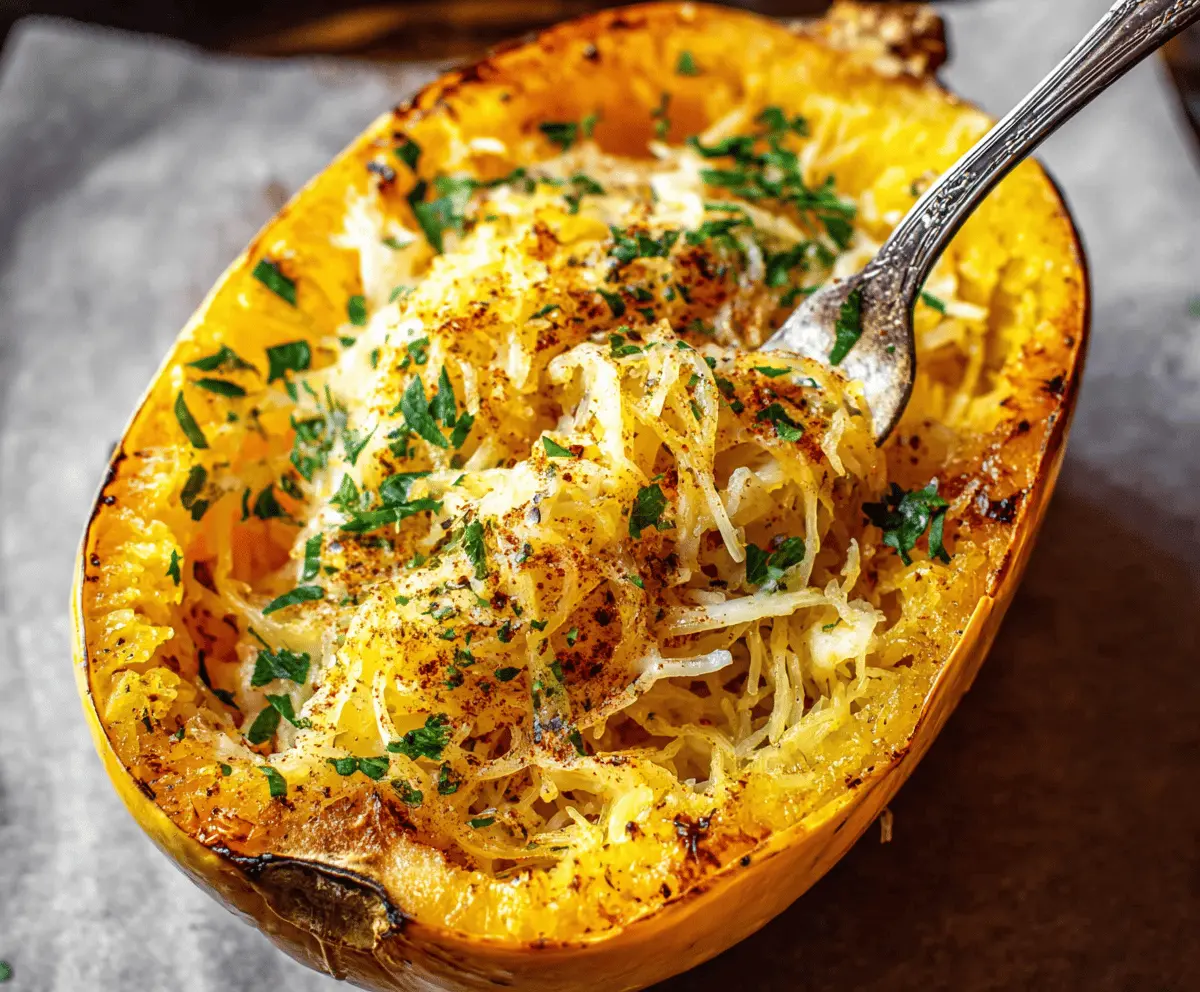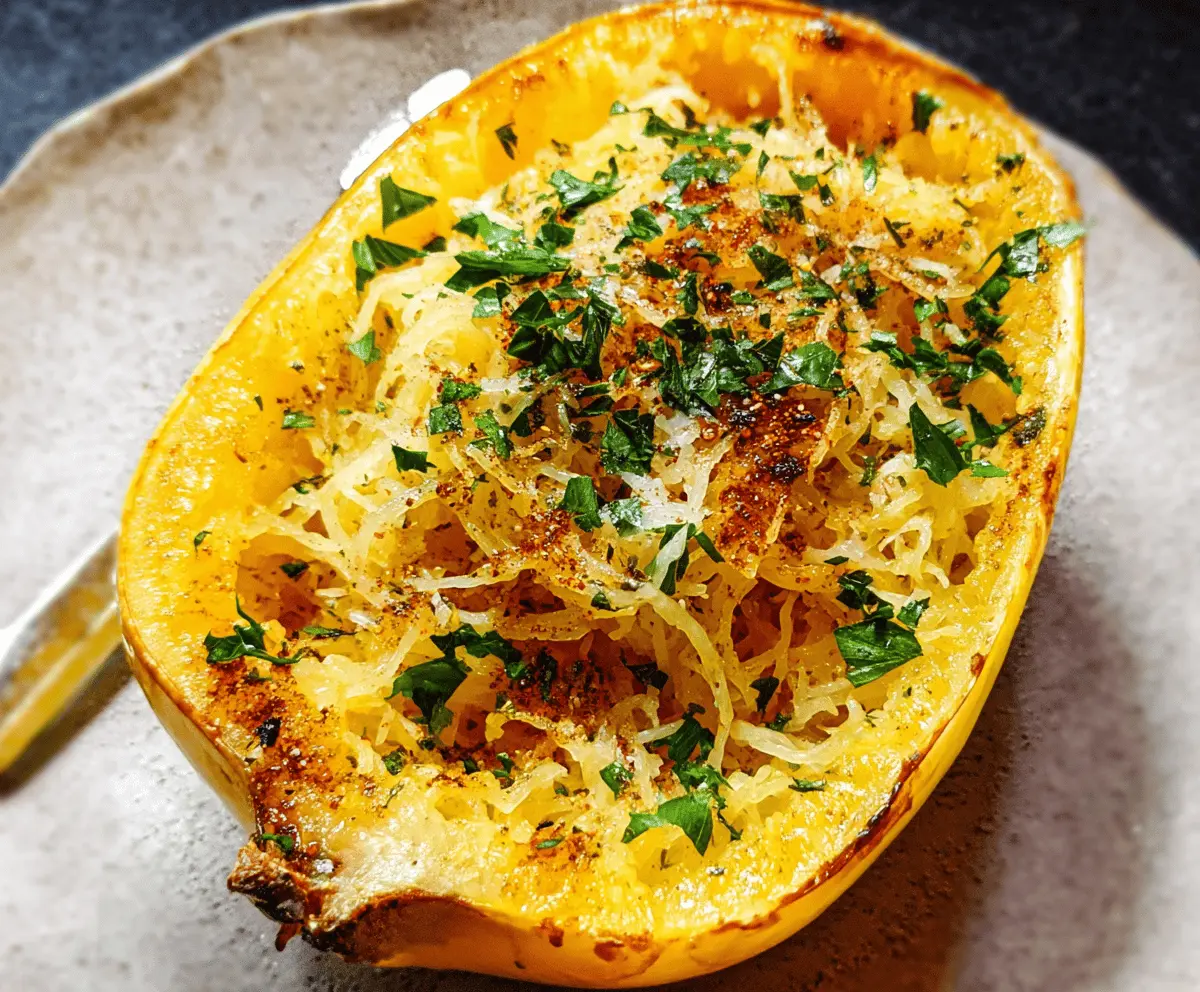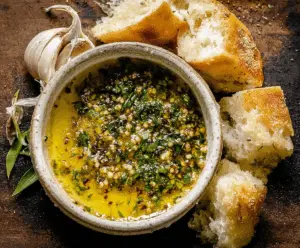The best spaghetti squash you’ve ever tasted is a simple and satisfying dish that turns the humble squash into strands that look and feel just like pasta. Roasted until tender, it has a slightly sweet flavor and a nice, light texture that makes it perfect for soaking up your favorite sauces. This dish feels fresh and bright but still comforting enough for any meal.
I love making this spaghetti squash because it’s so easy to prepare, but it always impresses everyone at the table. A quick roast and scrape with a fork, then I toss it with garlic, olive oil, and a sprinkle of Parmesan cheese — that’s my go-to. Sometimes I add fresh herbs or a little red pepper flakes for a bit of extra kick. It’s one of those dishes I keep coming back to because it’s healthy but never boring.
Whenever I serve this, I like to pair it with a simple salad or some grilled chicken for a complete meal. It’s perfect when you want something light but still filling, and it feels like a treat without any fuss. If you haven’t tried spaghetti squash this way, I promise it’s a game changer that might just become your new favorite.
Key Ingredients & Substitutions
Spaghetti squash: The star of the dish! Choose one that’s heavy for its size with a firm, yellow skin. If not available, butternut squash can work for a different texture and sweetness.
Olive oil: Adds richness and helps roast the squash perfectly. You can swap for avocado or grapeseed oil for a milder taste.
Garlic: Fresh garlic gives the dish a lovely aroma and depth. If you’re short on fresh, garlic powder can be used but use sparingly.
Parmesan cheese: This adds a salty, nutty finish. Try Pecorino Romano for a sharper kick or nutritional yeast for a vegan option.
Smoked paprika or chili powder (optional): Provides a subtle smoky or spicy layer. Feel free to skip or use your favorite spice blend for variation.
How Do I Roast Spaghetti Squash So It’s Tender and Easy to Shred?
Roasting is key to getting those perfect spaghetti-like strands that aren’t mushy or hard. Here’s how:
- Preheat your oven to 400°F (200°C) for consistent heat.
- Cut squash carefully lengthwise; it’s easier to handle when halved.
- Remove seeds to avoid any bitterness.
- Brush insides with olive oil and season well so the flavor seeps in while roasting.
- Roast cut side down on a baking sheet—this steams the squash and keeps it moist inside.
- Check tenderness by piercing with a fork after 35 minutes; it should go in easily.
- Once roasted, let it cool briefly then use a fork to shred gently—you want strands, not mush.
Taking your time with roasting makes all the difference. It keeps the squash strands firm yet tender and ready to soak up all the added garlic oil and cheese flavors.

Equipment You’ll Need
- Sharp chef’s knife – to safely cut the tough spaghetti squash in half.
- Baking sheet – sturdy and roomy enough to hold the squash halves without crowding.
- Aluminum foil or parchment paper – makes cleanup easier and prevents sticking.
- Fork – perfect for shredding the roasted squash into spaghetti-like strands.
- Small sauté pan – to gently cook the garlic in olive oil for extra flavor.
Flavor Variations & Add-Ins
- Swap Parmesan for mozzarella or feta for a creamier, tangier taste.
- Add cooked ground turkey or sausage for a hearty, protein-packed meal.
- Mix in roasted cherry tomatoes or sautéed mushrooms for extra freshness and texture.
- Sprinkle red pepper flakes or a pinch of Italian seasoning if you want more heat or herbal notes.

The Best Spaghetti Squash You’ve Ever Tasted
Ingredients You’ll Need:
- 1 medium spaghetti squash
- 2 tablespoons olive oil
- 2 cloves garlic, minced
- Salt, to taste
- Black pepper, to taste
- 1/2 teaspoon smoked paprika or chili powder (optional)
- 1/4 cup grated Parmesan cheese
- 2 tablespoons fresh parsley, chopped (for garnish)
How Much Time Will You Need?
This recipe takes about 10 minutes of preparation and approximately 40-50 minutes to roast the squash. Another 5 minutes will be spent finishing with garlic oil and cheese, so plan for around 1 hour total to enjoy this delicious dish.
Step-by-Step Instructions:
1. Prepare and Roast the Squash:
Preheat your oven to 400°F (200°C). Carefully cut the spaghetti squash in half lengthwise and scoop out the seeds. Drizzle each half with 1 tablespoon of olive oil and season with salt, pepper, and smoked paprika or chili powder if you like a smoky kick. Lay the halves cut side down on a baking sheet lined with parchment paper or foil. Roast for 35-45 minutes until the flesh is tender and a fork can easily pierce it.
2. Scrape and Dress the Squash:
When the squash is cool enough to handle, use a fork to scrape the flesh into spaghetti-like strands, keeping them in the shells if desired. In a small pan, heat the remaining tablespoon of olive oil over medium heat. Sauté the minced garlic for about 1 minute until fragrant but not browned. Pour this garlic oil over the spaghetti squash strands and toss gently to combine.
3. Add Cheese and Serve:
Sprinkle the grated Parmesan cheese evenly over the squash, then return to the oven for 5 minutes to let the cheese melt and get slightly golden. Remove from the oven, sprinkle with chopped fresh parsley, and serve warm. Enjoy your light and flavorful spaghetti squash – a tasty, healthy twist on pasta!
Can I Use Frozen Spaghetti Squash for This Recipe?
Yes, you can use frozen spaghetti squash! Just make sure to thaw it completely in the refrigerator overnight before cooking. The texture may be a bit softer, so keep an eye on roasting time to avoid overcooking.
How Can I Store Leftover Spaghetti Squash?
Store any leftovers in an airtight container in the refrigerator for up to 3-4 days. Reheat gently in the oven or microwave until warmed through. Toss with a splash of olive oil or water if it seems dry.
Can I Make This Spaghetti Squash Recipe Dairy-Free?
Absolutely! Simply omit the Parmesan cheese or substitute it with a vegan cheese alternative or nutritional yeast for a cheesy flavor without dairy.
What Can I Serve Spaghetti Squash With?
This spaghetti squash pairs beautifully with grilled chicken, roasted vegetables, or a fresh green salad. It also works well as a low-carb base for your favorite pasta sauces like marinara or pesto.


